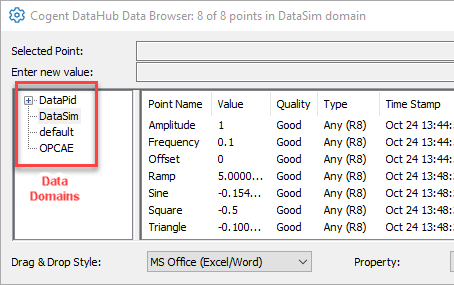The DataHub Architecture
A Single Unified Data Set (unified namespace)
The DataHub architecture provides a single, unified data set (also known as a unified namespace) through which connected servers and clients can exchange data. Each application connects using its own protocol, such as OPC, MQTT, DHTP, Modbus, ODBC, etc. Whenever a DataHub instance receives a change to a data point value, it immediately updates the data set, and then forwards the new value to every application subscribed to that point, in that application’s own protocol. On a modern CPU, each DataHub instance can process up to 100,000 data point changes per second in this way.
This architecture enables the DataHub program to simultaneously:
- Integrate data from multiple sources
- Redistribute data to multiple users
- Convert protocols in real time
- Support server-to-server connections
- Allow scripted interactions with raw data
- Support daisy chain connections for secure IoT
Benefits
- Quick and Complete Access to All Data: Every connected application has immediate access to all allowed data in the system.
- Flexible: You can create server-server bridges, build custom data domains with data from multiple sources, and manipulate or transform data with scripts as it passes through.
- Network-enabled: Any participant can be anywhere on the local network or the Internet.
- Protocol Appropriate: Each participant sees the data in its own protocol, independent of the data source protocol.
- Accessible: Data from any protocol is available to all DataHub integration features and utilities like Scripting, Redundancy, Security, and more.
- Protected: Connected applications are protected from irregular data sources. If a data source goes down, all clients have access to the last valid data until the source recovers.
Real-Time Protocol Conversions
This architecture enables real-time protocol conversion for DataHub products, including these:
| Conversion | Product | Conversion | Product | |
|---|---|---|---|---|
| OPC DA ↔ OPC UA | DataHub OPC Gateway | OPC ↔ Database | DataHub OPC Logger | |
| OPC ↔ MQTT | DataHub IoT Gateway | OPC A&E ↔ OPC DA | Add A&E | |
| OPC Server ↔ Server | DataHub OPC Bridge | Modbus ↔ OPC | Modbus OPC Server | |
| Custom ↔ Any | DataHub APIs | Modbus ↔ Database | DataHub Modbus Logger |
Data Organization
The unified data set is organized into sub-sets called data domains. Each application reads from and/or writes to points in one or more data domains. This architecture lets system administrators provide or restrict access to data points, on a per-domain basis.



